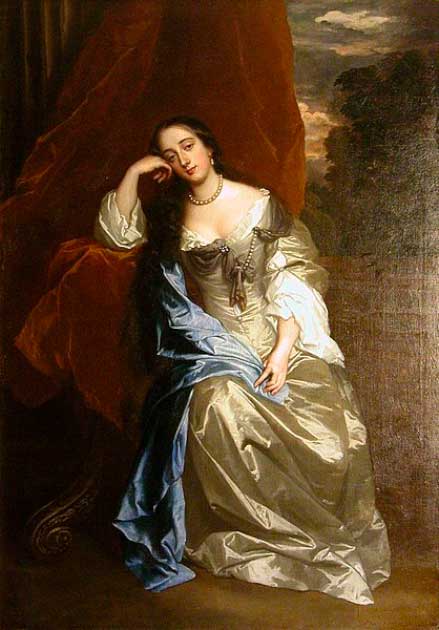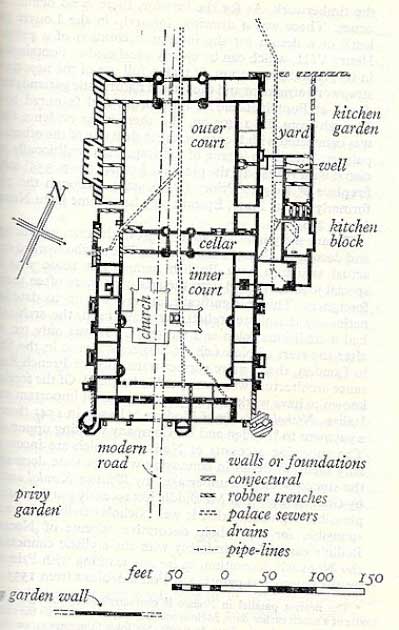Nonsuch Palace was a royal palace built during the Tudor period by Henry VIII in Surrey, just south of London. It was built in 1538 and stood until the late 17th century. Today what little remains of it can be found in Nonsuch Park between the towns of Epsom and Ewell.
It was once an enormous place, designed to be in opposition to Francis I of France, the great rival of Henry VIII. It was a completely new building surrounded by a vast royal park: it was to be one of his main hunting grounds.
But in the design and the location it can be seen that this great building was a break from the norm. Unlike earlier castles this was not built for war, being located far from a reliable water supply and set out to emphasize luxury and fine living. This was a palace, not a fortress.
And a very expensive palace, at that. All in all, Nonsuch cost around £24,000 in the 16th century which is the equivalent to £10 million today. In its design and layout it is considered a key part of the introduction of the Renaissance ideas to England.
But almost nothing remains, whereas other contemporary buildings have lasted almost unchanged to this day. What happened to Nonsuch, Henry VIII’s great palace?
A Monumental Undertaking
Nonsuch palace was one of the most grand and expensive building projects of Henry VIII’s reign. It was built on the site of Cuddington which is near Ewell. The site was prepared by destroying the church and village, although the villagers were compensated.
Work began on the 22nd of April 1538, which was the first day of Henry’s thirtieth regnal year. It was also six months after the birth of Edward his first son, so it would seem Henry was in a cheerful mood.

In the written record, Nonsuch appears in the building accounts by June of that year, and by all accounts it was a magnificent place, with documents regularly boasting that there was no palace that was its equal anywhere in the world. Construction continued throughout the 1530s and well into the 1540s.
- Cold Hearted: Why Did Empress Anna Ivanovna Build An Ice Palace?
- The Witch-Queen of England? Revisiting Anne Boleyn’s Guilt
Due to the size of the project, vast amounts of land were purchased, and several major roads were re-routed and bypassed to the palace. The area later became Nonsuch Great Park, Henry’s prized hunting ground.
What Happened to the Palace?
However it seems that the palace was too grand a design to be realized for Henry. Despite the amount of money that it cost; the palace was still incomplete when the king died in 1547. It was sold in 1556 by his daughter Mary I.
Henry FitzAlan, 19th Earl of Arundel was the man who bought it and who later completed it, but it was no longer a royal palace and records are less clear. It was certainly finished by the time that Elizabeth I and the Dutch Republic signed the Treaty of Nonsuch in 1585, and was clearly an impressive building.
By the 1590s, the palace was back under royal ownership as Anne of Denmark, who would later become consort of King James I, inherited it. However, the park area was not released from royal control until 1605, two years after the death of Elizabeth I.
It seems Anne did not care for the estate, rarely visiting it. James I first appointed Viscount Lumley as the keeper of the palace and the park area surrounding it. In 1606, he was succeeded by the Earl of Worcester who renamed the lodge there Worcester House. James I and the later Charles I were known to have visited to enjoy the racing and hunting the estate afforded.
The Nonsuch estate was confiscated in the 17th century, however, when Parliament won the English Civil War. It was let out to Parliamentarian supporters. First was Algernon Sidney, a commissioner at the trial of Charles I, and then Colonel Robert Lilburne, a respected general within the army.
It was finally sold to Major-General John Lambert who was regarded as one of the most talented generals in the parliamentary army before being passed to Thomas Pride who was a key player in the trial and beheading of Charles I in 1649. He held it until his eventual death in 1658.
The Palace of Nonsuch was given back to royal hands after 1660 when the monarchy was reinstated. It was given to Queen Henrietta Maria. There is a written account from 1666 from John Evelyn who visited and talked about the various decorations, emblems, and reliefs that decorate the palace but, ominously, these notes also commented on how the palace had started to deteriorate.

The palace remained in royal hands until 1670 when Charles II gave it to his mistress Barbara, Countess of Castlemaine. Sadly, this was the death knell for the palace: Barbara had nonsuch summarily demolished and sold off to pay for her gambling debts.
- Sacsayhuaman: Incan Fortress or Palace of Worship?
- The Glorious Revolution: Did the Dutch Steal the English Crown?
Some of the materials and elements were incorporated into other buildings. The wood paneling is located and still can be seen today at the Great Hall in Losely Park. Sadly, there is no trace of the original building left today.
The British Museum holds some pieces that can be seen, and you can still see the land on which the old church used to be before it was demolished. It seems that Nonsuch was too large and too expensive to maintain for anyone apart from royalty, and so for the price of a few debts it was lost forever.
Archaeological Evidence
Today, there are only three contemporary images of the palace that can still be seen. They do not, however, reveal much about the layout or the details of how the structure was organized or built.
Following the digging of trenches on the estate during WWII, there were reports of pottery being found in the area where the palace stood. The layout is also still visible from the air which can provide additional evidence of what it may have looked like.
In 1959=60 the grounds were extensively excavated, and much was learned about the palace. The dig revealed that the palace had inner and outer courtyards with fortified gatehouses. The outer courtyards were relatively plain whilst the inner courtyards revealed decorative stucco panels that were molded in high relief.
It was fortified in a medieval style to the north but had ornate and lavish decorations in the south representing a more Renaissance style. The excavations were one of the first post-medieval sites to be investigated and helped to develop post-medieval archaeology.

One of the most impressive aspects of the palace was the gardens. There is a contemporary account of them that exists in John Speed’s Map of Surrey from 1610. It shows how the gardens were designed and the spectacular ornaments that decorated them, including large fountains and pyramid obelisks.
But it is sad that so little remains. This was perhaps one of the most expensive building projects that Henry VIII took on, and the king was known for his grand projects. Before this project, he emptied the coffers in a similar vein as he tried to outdo and outshine Francis I at the Field of the Cloth of Gold.
This type of lavish spending was a mainstay of Henry VIII’s reign. The real tragedy lies, however, that it no longer stands in its full glory to be seen in completion today.
Top Image: Queen Elizabeth I comes to visit Nonsuch Palace. Source: British Museum / Public Domain.
By Kurt Readman